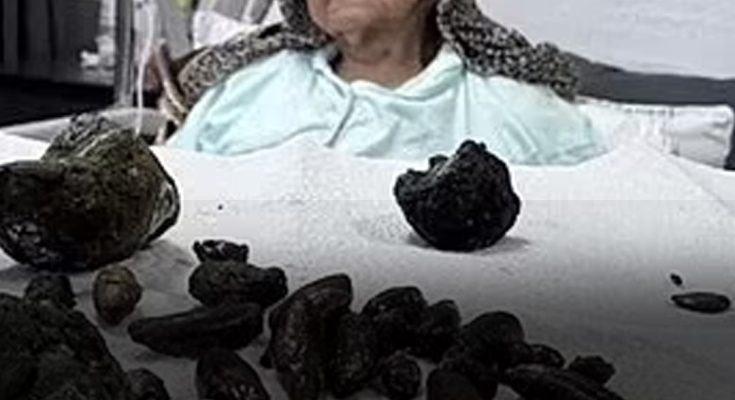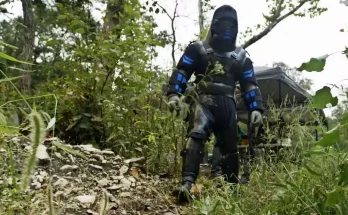Doctors in Turkey have warned of the life-threatening dangers of swallowing olive pips, after a 92-year-old almost died when her bowel was ripped apart by one of the dozens of seeds in her digestive tract.
Horrifying images show the astonishing collection of blackened stones that had accumulated in the digestive system of the patient, Şerife Ay.
Surgeons removed a total of 28 date seeds, 35 olive pits, and five fist-sized rock-like objects from her stomach and bowel.
These rocks were made of several date stones that formed a collective mass over time, ranging from 5.5 to 6cm in diameter.
It’s unknown how long Ms Ay, a widow from Zonguldak in the country’s north bordering the Black Sea, had been swallowing the fruit stones — but she didn’t suffer any ill effects until a 4cm stone ended up blocking her small intestine.
This stone then made a hole in the organ, which in turn caused the tissue to decay, a potentially life-threatening injury.
Ms Ay was brought to hospital by her children on February 5 after she complained of stomach pain and vomiting.
Medics who examined her sent her to Zonguldak Bülent Ecevit University Hospital, where she underwent a CT scan.

Horrifying images show the astonishing collection of blackened fruit stones and masses that had accumulated in the digestive system of 92-year-old Şerife Ay

Surgeons removed 28 date seeds and 35 olive pits as well as five fist-sized rock-like masses from her stomach and small intestine
This revealed the presence of dozens of smaller individual fruit stones as well as the five larger rock-like masses.
Rushing the elderly woman to surgery, medics performed a two-hour operation in which they removed the damaged sections of the bowel and reconnected the healthy tissue.
They also removed all of the seeds and stones from her organs, and Ms Ay spent another five days in intensive care recovering from the procedure.
Local media reported that Ms Ay said she loved dates and olives very much and she had always swallowed the seeds.
‘My daughter in the village said, “Mom, give me the seeds.” I said, “No” and swallowed them, but over time I couldn’t eat bread or drink water. Everything got stuck in my throat,’ she said according to Turkish news website Haberler.
But after her harrowing experience she said she’d never touch them again.
‘I am fine now. I will never touch seeds again. I was going to separate the seeds; the fault is mine. No one should swallow seeds,’ she said.
Dr İlhan Taşdöven, a surgeon at the hospital that treated Ms Ay, said she was lucky she sought medical help when she did.

Dr İlhan Taşdöven, a surgeon at the hospital that treated Ms Ay, said she was lucky to have sought medical help when she did. He posted a clip on TikTok showing the stones and pits that had accumulated in her organs
‘If she had continued like this at home with abdominal pain, we would have had a high chance of losing our patient due to blood poisoning,’ he said.
Obstructions in the digestive system from food matter can lie silent in the digestive system for years as, providing they do not block or obstruct the normal function of the organs, they cause no symptoms.
But they can cause a host of problems if they do, including nausea, abdominal pain, vomiting, ulcers and even internal bleeding.
Treatment varies depending on what the mass is made of, with other examples being hair or chewing gum.
Surgery is generally considered a last, or emergency, resort, with some medics using dark sodas like Coca-Cola or Pepsi as an unlikely initial treatment.
According to an article published in Practical Gastroenterology in 2021, the slight acidity from the sodas and their carbon dioxide content aids breaking up some types of masses.
This is typically done by giving a patient three litres of sodas to consume in 24 hours.
Medical reviews have found using sodas in this way is only successful 23 to 60.6 per cent of the time.

The biggest objects found in Ms Ay were collections of date stones which had formed collective masses over time, medically known as a bezoar, and which ranged from 5.5 to 6cm in diameter. Stock image
However, the low cost and low risk nature of the intervention means it is often attempted anyway.
Estimates of these types of masses in the population vary but they are considered very rare.
Some studies put the rate in the population at between 0.07 to 0.4 per cent of the population, roughly between one in 250 people or fewer than one in a 1,000.
Others state most centres which specialise in gastroenterology — the treatment of diseases of the digestive system — will only see, on average, 2.5 cases per year, but this can rise to 16.5 per year in some countries.



